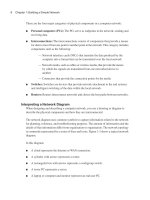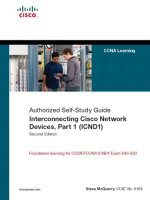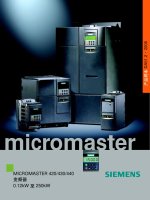Tài liệu Interconnecting Cisco Network Devices P1 ppt
Bạn đang xem bản rút gọn của tài liệu. Xem và tải ngay bản đầy đủ của tài liệu tại đây (644.04 KB, 30 trang )
800 East 96th Street
Indianapolis, Indiana 46240 USA
Cisco Press
Authorized Self-Study Guide
Interconnecting Cisco
Network Devices,
Part 1 (ICND1)
Second Edition
Steve McQuerry,
CCIE No. 6108
ii
Interconnecting Cisco Network Devices, Part 1 (ICND1)
Second Edition
Steve McQuerry, CCIE No. 6108
Copyright© 2008 Cisco Systems, Inc.
Cisco Press logo is a trademark of Cisco Systems, Inc.
Published by:
Cisco Press
800 East 96th Street
Indianapolis, IN 46240 USA
All rights reserved. No part of this book may be reproduced or transmitted in any form or by any means, electronic or
mechanical, including photocopying, recording, or by any information storage and retrieval system, without written
permission from the publisher, except for the inclusion of brief quotations in a review.
Printed in the United States of America
First Printing December 2007
Library of Congress Cataloging-in-Publication Data:
McQuerry, Steve.
Authorized self-study guide : interconnecting Cisco network devices.
Part 1 (ICND1) / Steve McQuerry. —2nd ed.
p. cm.
Includes index.
ISBN 978-1-58705-462-4 (hbk.)
1. Internetworking (Telecommunication)—Examinations—Study guides. 2. Computer networks—Problems,
exercises, etc. 3. Telecommunications engineers—Certification—Examinations—Study guides. I. Title. II.
Title: Interconnecting Cisco network devices, part 1 (ICND1).
TK5105.5.M3399 2007
004.6—dc22
2007043780
ISBN-13: 978-1-58705-462-4
ISBN-10: 1-58705-462-0
Warning and Disclaimer
This book is designed to provide information about Interconnecting Cisco Network Devices, Part 1 (ICND1). Every
effort has been made to make this book as complete and as accurate as possible, but no warranty or fitness is implied.
The information is provided on an “as is” basis. The authors, Cisco Press, and Cisco Systems, Inc. shall have neither
liability nor responsibility to any person or entity with respect to any loss or damages arising from the information
contained in this book or from the use of the discs or programs that may accompany it.
The opinions expressed in this book belong to the author and are not necessarily those of Cisco Systems, Inc.
iii
Feedback Information
At Cisco Press, our goal is to create in-depth technical books of the highest quality and value. Each book is crafted
with care and precision, undergoing rigorous development that involves the unique expertise of members from the
professional technical community.
Readers’ feedback is a natural continuation of this process. If you have any comments regarding how we could
improve the quality of this book, or otherwise alter it to better suit your needs, you can contact us through email at
Please make sure to include the book title and ISBN in your message.
We greatly appreciate your assistance.
Corporate and Government Sales
The publisher offers excellent discounts on this book when ordered in quantity for bulk purchases or special sales,
which may include electronic versions and/or custom covers and content particular to your business, training goals,
marketing focus, and branding interests. For more information, please contact:
U.S. Corporate and Government Sales 1-800-382-3419
For sales outside the United States, please contact:
International Sales
Trademark Acknowledgments
All terms mentioned in this book that are known to be trademarks or service marks have been appropriately capitalized.
Cisco Press or Cisco Systems, Inc., cannot attest to the accuracy of this information. Use of a term in this book should
not be regarded as affecting the validity of any trademark or service mark.
Publisher Paul Boger
Associate Publisher Dave Dusthimer
Cisco Representative Anthony Wolfenden
Cisco Press Program Manager Jeff Brady
Executive Editor Brett Bartow
Managing Editor Patrick Kanouse
Development Editor Ginny Bess Munroe
Copy Editor Kevin Kent and Written Elegance, Inc.
Technical Editors Matthew C. Brussel
Tami Day-Orsatti
Kevin Wallace
Editorial Assistant Vanessa Evans
Designer Louisa Adair
Composition ICC Macmillan Inc.
Indexer Tim Wright
Proofreader Water Crest Publishing
iv
About the Author
Steve McQuerry, CCIE No. 6108, is a consulting systems engineer with Cisco Systems
focused on data center architecture. Steve works with enterprise customers in the
midwestern United States to help them plan their data center architectures. Steve has been
an active member of the internetworking community since 1991 and has held multiple
certifications from Novell, Microsoft, and Cisco. Prior to joining Cisco, Steve worked as an
independent contractor with Global Knowledge, where he taught and developed
coursework around Cisco technologies and certifications.
v
About the Technical Reviewers
Matthew C. Brussel is currently leading accelerated certification training courses for
Training Camps that specialize in MCSE: Security 2003, MCDST XP, A+, Net+, Security+,
CCNA, CCDA, and others. After studying IT, economics, and accounting in college,
Matthew has been an IT consultant, pre-sales engineer, and IT trainer in various capacities
for over 20 years. He has worked as a traditional trainer and as an accelerated technical
certification boot camp trainer for well over the last 10 years. Matthew also contributes to
custom content and exam prep study guides and participates in various technical writing
and technical editing projects. Previously, Matthew worked as an IT consultant for over
10 years in Portsmouth, RI; Stamford, CT; Greenwich, CT; and New York City. Now
traveling to Training Camp sites all across America, he currently resides in central Florida.
He has over 70 technical certifications and exams to his credit, including Microsoft MCT,
MCSE 2003 with Security and Messaging, CCNA, CCDA, A+, Network+, I-Net+,
Security+, and CTT+ (Written). Matthew can be reached at
Tami Day-Orsatti, CCSI, CCDP, CCNP, CISSP, ECI, EMCPA, MCT, MCSE: 2000/2003
Security, is an IT networking, security, and data storage instructor for T
2
IT Training. She
is responsible for the delivery of authorized Cisco, (ISC)
2
, EMC, and Microsoft classes.
She has over 23 years in the IT industry working with many different types of organizations
(private business, city and federal government, and DoD), providing project management
and senior-level network and security technical skills in the design and implementation of
complex computing environments. She maintains active memberships in local and national
organizations such as (ISC)
2
, ISSA, and SANS.
Kevin Wallace, CCIE No. 7945, is a certified Cisco instructor and a full-time instructor of
Cisco courses. With 18 years of Cisco networking experience, Kevin has been a network
design specialist for The Walt Disney World Resort and a network manager for Eastern
Kentucky University. Kevin holds a bachelor’s of science degree in electrical engineering
from the University of Kentucky. Kevin is also a CCVP, CCSP, CCNP, and CCDP, and he
holds multiple Cisco IP communication and security specializations. Additionally, Kevin
has authored several books for Cisco Press, including CCNP Video Mentor, Voice over IP
First-Step, and Cisco Voice over IP, Second Edition.
vi
Dedication
This work is dedicated to my family. Becky, as the years go by, I love you more. Thank you
for your support and understanding. Katie, your work ethic has always amazed me. As you
prepare to move into the next phase of your life, remember your goals and keep working
hard and you can achieve anything. Logan, you have never believed there was anything you
couldn’t do. Keep that drive and spirit and there will be no limit to what you can
accomplish. Cameron, you have a keen sense of curiosity that reminds me of myself as a
child. Use that thirst for understanding and learning, and you will be successful in all your
endeavors.
vii
Acknowledgments
There are a great number of people that go into publishing a work like this, and I would like
to take this space to thank everyone who was involved with this project.
Thanks to the ICND course developers. Most of this book is the product of their hard work.
Thanks to the technical editors, Tami Day-Orsatti, Kevin Wallace, and Matt Brussel, for
looking over this work and helping maintain its technical integrity.
Thanks to all the real publishing professionals at Cisco Press. This is a group of people that
I have had the pleasure of working with since 1998, and it has been a joy and honor. Thanks
to Brett Bartow for allowing me the opportunity to write for Cisco Press once again and to
Chris Cleveland for gently reminding me how to write again after a three-year break. It's
defiantly not as easy as riding a bike. Thanks to Ginny Bess Munroe for keeping the work
flowing and dealing with my bad jokes. Also to Kevin Kent and John Edwards (Written
Elegance), you are the best in the industry.
Thanks to my manager at Cisco, Darrin Thomason, for trusting me to keep all my other
projects managed while working on this project in my spare time. (Wait, do we have spare
time at Cisco?)
Thanks to my customers, colleagues, and former students. Your questions, comments, and
challenges have helped me to continue to learn and helped teach me how to pass that
information to others.
Thanks to my family, for their patience and understanding during this project and all my
projects.
Most importantly, I would like to thank God, for giving me the skills, talents, and
opportunity to work in such a challenging and exciting profession.
viii
ix
Contents at a Glance
Foreword xxii
Introduction xxiii
Chapter 1 Building a Simple Network 3
Chapter 2 Ethernet LANs 139
Chapter 3 Wireless LANs 207
Chapter 4 LAN Connections 237
Chapter 5 WAN Connections 345
Chapter 6 Network Environment Management 425
Appendix Answers to Chapter Review Questions 465
Index 480
x
Contents
Foreword xxii
Introduction xxiii
Chapter 1 Building a Simple Network 3
Chapter Objectives 3
Exploring the Functions of Networking 3
What Is a Network? 4
Common Physical Components of a Network 5
Interpreting a Network Diagram 6
Resource-Sharing Functions and Benefits 7
Network User Applications 9
The Impact of User Applications on the Network 10
Characteristics of a Network 11
Physical Versus Logical Topologies 12
Physical Topologies 12
Logical Topologies 13
Bus Topology 14
Star and Extended-Star Topologies 15
Star Topology 15
Extended-Star Topology 15
Ring Topologies 17
Single-Ring Topology 17
Dual-Ring Topology 18
Mesh and Partial-Mesh Topologies 18
Full-Mesh Topology 18
Partial-Mesh Topology 19
Connection to the Internet 20
Summary of Exploring the Functions of Networking 21
Securing the Network 21
Need for Network Security 22
Balancing Network Security Requirements 25
Adversaries, Hacker Motivations, and Classes of Attack 26
Classes of Attack 27
Mitigating Common Threats 28
Physical Installations 28
Reconnaissance Attacks 29
Access Attacks 30
Password Attacks 30
Summary of Securing the Network 31
References 31
Understanding the Host-to-Host Communications Model 31
OSI Reference Model 32
Layer 7: The Application Layer 34
xi
Layer 6: The Presentation Layer 34
Layer 5: The Session Layer 35
Layer 4: The Transport Layer 35
Layer 3: The Network Layer 35
Layer 2: The Data Link Layer 35
Layer 1: The Physical Layer 36
Data Communications Process 36
Encapsulation 37
De-Encapsulation 38
Peer-to-Peer Communication 39
The TCP/IP Protocol Stack 40
OSI Model Versus TCP/IP Stack 41
Summary of Understanding the Host-to-Host Communications Model 42
Understanding TCP/IP’s Internet Layer 43
IP Network Addressing 44
IP Address Classes 46
Network and Broadcast Addresses 49
Public and Private IP Addresses 53
Address Exhaustion 54
Dynamic Host Configuration Protocol 58
Domain Name System 58
Using Common Host Tools to Determine the IP Address of a Host 59
Summary of TCP/IP’s Internet Layer 62
Understanding TCP/IP’s Transport and Application Layers 63
The Transport Layer 63
TCP/IP Applications 67
Transport Layer Functionality 67
TCP/UDP Header Format 69
How TCP and UDP Use Port Numbers 72
Establishing a TCP Connection: The Three-Way Handshake 74
Session Multiplexing 77
Segmentation 78
Flow Control for TCP/UDP 78
Acknowledgment 79
Windowing 80
Fixed Windowing 80
Example: Throwing a Ball 80
TCP Sliding Windowing 82
Maximize Throughput 83
Global Synchronization 83
Summary of Understanding TCP/IP’s Transport and Application Layers 83
Exploring the Packet Delivery Process 84
Layer 1 Devices and Their Functions 84
Layer 2 Devices and Their Functions 85









